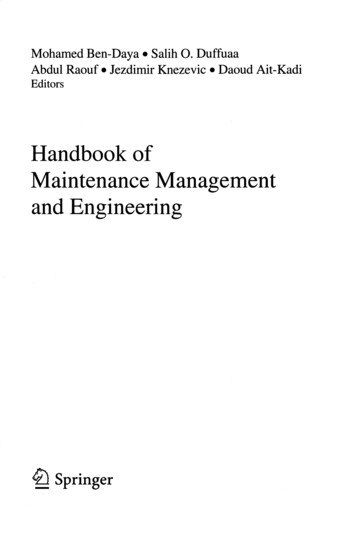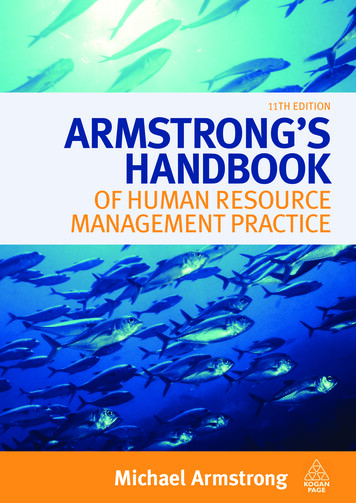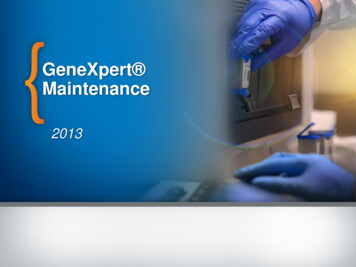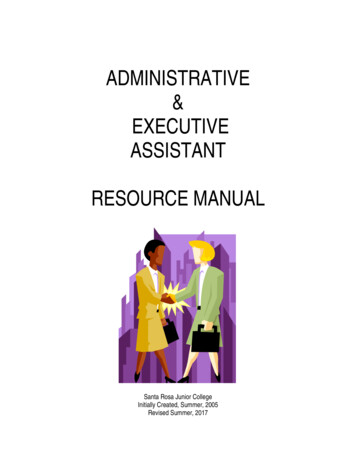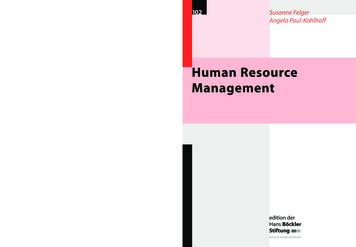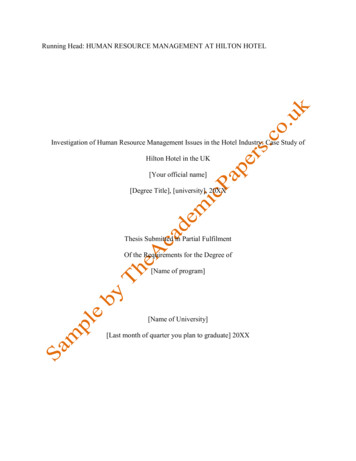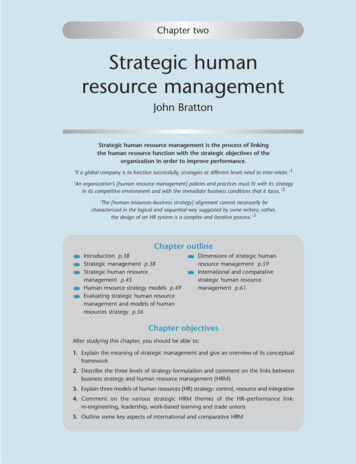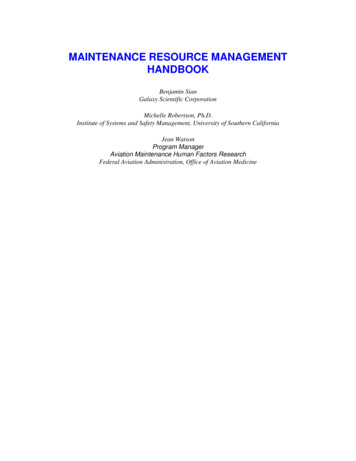
Transcription
MAINTENANCE RESOURCE MANAGEMENTHANDBOOKBenjamin SianGalaxy Scientific CorporationMichelle Robertson, Ph.D.Institute of Systems and Safety Management, University of Southern CaliforniaJean WatsonProgram ManagerAviation Maintenance Human Factors ResearchFederal Aviation Administration, Office of Aviation Medicine
List of TablesTable 1.1Behavioral Team Skills Identified in CRM and MRMTable 1.2Differences in CRM and MRM (Human Error)Table 1.3Differences in CRM and MRM (Human Factors Training)Table 1.4Differences in CRM and MRM (Communication)Table 1.5Differences in CRM and MRM (Team Composition)Table 1.6Differences in CRM and MRM (Teamwork)Table 1.7Differences in CRM and MRM (Worker Safety)Table 1.8Differences in CRM and MRM (Situation Awareness)Table 1.9Differences in CRM and MRM (Leadership)Table 2.1Effective TeamworkTable 2.2Guidelines in Choosing a Leadership StyleTable 2.3Leadership ResponsibilitiesTable 2.4Leadership GuidelinesTable 3.1Five-Step Evaluation Process
List of FiguresFigure 1.1The Evolution of Aviation Maintenance Human Factors TrainingFigure 2.1“Swiss Cheese” Model of Accident CausationFigure 3.1The Instruction Systems Design (ISD) Model
Chapter 1 INTRODUCTION TO MAINTENANCE RESOURCEMANAGEMENTINTRODUCTIONThough much has been made of crew resource management (CRM) on the flight deck, relatively littleattention has been paid to its maintenance-related counterpart, maintenance resource management(MRM). Indeed, this oversight is understandable. Whereas a pilot or pilots’ errors can have immediateand highly visible effects, the same can not necessarily be said of a maintenance-based error. Because ofthis, aviation research into team activities first grew from investigations into aircrew behaviors. Thisevolution is apparent whenever one encounters references to “cockpit” resource management.The aviation community has since become much more sophisticated in their approach to reducing humanerror. Human factors research now encompasses not just the flight crew, but all aspects of aviation inwhich a human may be involved. This research includes such areas as aircraft design and operation, airtraffic control, and, of course, aircraft maintenance.OBJECTIVESThis handbook was created to help outline and to provide background information on MaintenanceResource Management. Maintenance Resource Management (MRM) is a “general process for improvingcommunication, effectiveness and safety in aircraft maintenance operations.”1 Attention will be givenspecifically to the implementation and evaluation of MRM training. Much as crew resource management(CRM) was created to address safety and teamwork issues in the cockpit, Federal AviationAdministration (FAA) researchers, in conjunction with industry partners, developed MRM to addressteamwork deficiencies within the aviation maintenance environment. By doing so, it is hoped that MRMwill foster a culture of safety in all maintenance operations.MRM HISTORY AND BACKGROUNDFrom CRM to MRM: A Historical PerspectiveMaintenance Resource Management is the result of a series of events that drove its development. First,MRM’s development is directly linked to the creation of Cockpit Resource Management (CRM). Thecatalyst for the development of CRM, the United Airlines (UAL) Flight 173 DC-8 accident, is describedbelow:2As the DC-8 was approaching Portland, Oregon, the flight crew noticed a problem with the landing gear.The pilots kept flying while trying to resolve the problem, thus diverting their attention from the task ofmonitoring other critical systems. Eventually, they ran out of fuel and crashed short of the runway,killing 10 people. This accident, a classic controlled flight into terrain (CFIT) event, resulted in United
Airlines initiating Cockpit Resource Management (CRM) training.Figure 1.1 The Evolution of Maintenance Human Factors TrainingThe UAL CRM workshop concentrated on improving communication among pilots and other crewmembers on the flight deck. This program eventually evolved into Crew Resource Management, whichpertains to utilizing resources outside the cockpit. This training is now sometimes calledCommand/Leadership/Resource Management (CLR).In addition to CRM and CLR, airlines also created Line Oriented Flight Training (LOFT). LOFTincorporates flight simulators to create better working relationships by devising realistic scenarios thatrequire the use of CRM skills. The feedback that can be given to teams after this type of trainingreinforces the development of communication and coordination.3Just as CRM grew from a reaction to a tragic event, another key mishap led to the development of MRMand maintenance-based human factors training. In 1988, Aloha Airlines Flight 243 suffered anear-catastrophic failure.4 Eighteen feet of fuselage skin separated from the aircraft at an altitude of
24,000 feet, forcing an emergency landing. After this accident, the FAA issued an AirworthinessDirective (AD) requiring a close visual inspection of 1300 rivets on B-737 aircraft.5The Aloha B-737 involved in this accident had been examined as required by AD 87-21-08 by two AlohaAirlines inspectors. One inspector had 22 years experience and the other, the chief inspector, had 33years experience. Neither found any cracks in their inspection. Post-accident analysis determined therewere over 240 cracks in the skin of this aircraft.4 The ensuing investigation identified manyhuman-factors-related problems leading to the failed inspections. Findings showed that although Aloha’smaintenance management group were technically knowledgeable and possessed the requisite expertise,organizational factors reduced the effectiveness of their maintenance programs. These findings focusedattention onto maintenance and aviation maintenance technicians (AMTs) as potential accident causalfactors and led to the development of MRM and human factors training.Due in part to this new focus, in 1991 Continental Airlines expanded and modified its Crew ResourceManagement training to become Crew Coordination Concept (CCC) training -- designed specifically forits Maintenance Technical Operations. CCC is the precursor of what has become known as MRM. MRMshares certain basic features with CRM, including addressing the issues of communication and teamcoordination. The target audience for MRM includes aviation maintenance technicians (AMTs), staffsupport personnel, inspectors, engineers, and managers--a much more diverse group than cockpit crews.Since 1991, over 2,000 technical operations personnel and managers have attended the 16-hour CCCcourse.6 The objective was “to equip all technical operations personnel with the skill to use all resourcesto improve safety and efficiency.” Subsequent evaluation of CCC, over the course of three years, showedpositive and significant effects on safety, assertive communication, team coordination, stressmanagement, and dependability.7CCC was shown to reduce maintenance error rates and to improve human reliability in measurable terms,based on a wide variety of objective performance data. Thus, Continental Airlines was able todemonstrate successfully the positive effects of its first “MRM” training course. This course provided, inpart, the inspiration to develop other MRM training courses.6,7Similarly, in response to the 1989 crash of Air Ontario Flight # 26, Transport Canada developed theHuman Performance in Maintenance workshop. These efforts were conducted in parallel with CCC.Crew coordination was identified as a contributing factor to this accident. The first workshop, held inJanuary 1994, was successful in providing a heightened awareness of human factors problems andsolutions in the maintenance environment. One outcome was the identification of the “Dirty Dozen”--12human factors elements that degrade people’s ability to perform effectively and safely.8 These dirtydozen are listed below:1.2.3.4.5.6.Lack of CommunicationComplacencyLack of KnowledgeDistractionLack of TeamworkFatigue7.8.9.10.11.12.Lack of ResourcesPressureLack of AssertivenessStressLack of Awareness“Destructive” Workplace NormsIn response to these initial successes, industry began to develop their own organization-specific MRM
programs. US Airways (formerly US Air) developed an MRM program that continues to evolve.9,10,11This program is the product of a partnership consisting of the following: maintenance management labor, i.e., the International Association of Machinist & Aerospace Workers (IAM&AW) the FAA Flight Standards District Offices (FSDO) FAA researchersUS Airways’ MRM activities include: participatory methods to reduce paperwork errors a paperwork training course and pre-shift meetings problem solving meetings (called round tables) that involve management, IAM&AWrepresentatives, AMTs, and the FAAUS Airways designed and developed an MRM training course using a participatory design process. Thedevelopment group was an interdisciplinary team of subject matter experts (SMEs) including AMTs,inspectors, managers, human factors and training experts, academic researchers, and representatives fromthe FAA.The US Airways’ MRM course provides all maintenance and technical operations personnel with humanfactors knowledge, an understanding of how maintenance errors occur, safety and situation awareness,communication, assertiveness training, and other team-related skills. After the first course is delivered, afollow-up MRM course is given in 90-120 days for further skill development and practice in MRMprinciples.Several other airlines (e.g., United, Northwest, Southwest, American Eagle) have designed human factorstraining courses for maintenance operations. These courses are typically based on what is known ashuman performance improvement methods, or HPIM. (This is to be differentiated from HumanPerformance in Maintenance, also shortened to HPIM.) Common HPIM elements include basic humanfactors courses, other human factors training materials developed by the FAA, and the airline’s ownhuman-factors-related experiences and case studies.Other companies are currently undertaking the design and development of additional MRM training thatincorporates team situation awareness training.12 Many repair stations are purchasing MRM trainingcourses from contractors, and some AMT schools have incorporated an advanced technology teamtraining program into their curriculum.13Delta Air Lines has designed and developed a Team Resource Management (TRM) course for their rampworkers. They have begun to implement this training course and are concurrently establishing practicesthat will reinforce TRM skills in the working environment.14 A comprehensive study of European groundservice and ramp personnel has also been completed.15From CRM to MRM: Theoretical Perspective
One of the most intensely studied teams is air and cockpit crews.16 Previous research demonstrated thataircraft accidents could be traced to human error on the part of the flight crew.17 It was determined thatalthough each crew member possessed the necessary knowledge and skills for completing his or her jobindividually, the members of the crew lacked the coordination that characterizes team interdependence.These results became the basis for a systematic training program that identifies behaviors and teachescoordination among flight crew members. This intervention is commonly known as Crew ResourceManagement (CRM).CRM researchers identified basic skills necessary for coordination among flight crew members to occur.Among these behaviors are communication, situation awareness, decision-making, leadership,adaptability (also called “flexibility”), and assertiveness.18 Overall, studies of CRM-type programsdemonstrate that training these specific behaviors has a positive effect on performance andperformance-related attitudes.19Because CRM has been identified as a skill set necessary for the safe operation of aircraft, the FAA hasoutlined CRM training for all multi-crew pilots.20 This training, as defined by the FAA, encompassesawareness training, practice, and continuous reinforcement. This is also the structure around whichMRM was designed and implemented.A review of the literature shows a great deal of transfer of CRM-related behaviors and skills to MRM.For example, Cannon-Bowers, et al., conducted an extensive review of literature of both theoretical andapplied team research in other domains that included CRM, and summarized the behavioral skilldimensions that they found were common to most teams.21 Though the identified skills vary in labelsused in each study, Cannon-Bowers, et al., generated eight core skills common to almost all studies.21These are listed below:1.adaptability2.shared situation awareness3.performance monitoring and feedback4.leadership/team management5.interpersonal skills6.coordination skills7.communication skills8.decision making skillsBoth CRM and MRM are no exception to the list presented above. The following table is the result ofadditional reviews by these authors. Table 1.1 presents a series of behavioral skills common to both CRMand MRM training. Initial research into CRM first identified these specific skills.16,18,19,20,21,23Follow-up research in the maintenance environment tested the validity, in terms of acceptance andeffectiveness, of those skills for MRM.6,24,25,26,27,28
Table 1.1 Behavioral Team Skills Identified in CRM and MRMBehavioral Team SkillsCommunication & Decision Making· briefings· assertiveness· conflict resolution· communicationTeam Building & Maintenance· leadership· team climate (norms)· interpersonal climateWorkload Management & (Team) Situation Awareness· preparation· planning· vigilance· decision making· workload managementIt must be noted that although team-related behavior and coordination remain the focus of both CRM andMRM, both philosophies encompass much more. Also included, though dependent on the syllabi of eachspecific program, are an introduction to basic human factors concepts, training in human errorrecognition, and worker stress recognition and reduction among other things.Similarities between CRM and MRM notwithstanding, they are and should be perceived as two distinctprograms; certain CRM principles can not be generalized to AMTs. Differences in the trainingpopulation, knowledge and skill sets, and even the basic tasks make MRM a wholly unique initiative.The remainder of this section details many of these differences.Though CRM and MRM are similar in both goals and scope, differences lie in both their target audiencesand the job tasks they address. In terms of audience, flight crews are relatively homogeneous in terms ofeducation and experience when compared to AMTs. AMTs, on the other hand, vary widely in theireducation and experience.8The very nature of maintenance tasks dictates important differences between CRM and MRM training.For example, maintenance crews often are separated from one another by time and space (e.g., separateshifts, hanger versus shop, etc.) Therefore, added effort is invested into teaching maintenance personnel asystemic perspective so that they can better learn how their individual actions fit into maintenanceoperations as a whole. As one thinks more carefully on the subject, more differences become apparent.The following (Tables 1.2-1.9) is a sampling of how CRM and MRM differ in terms of the basic skillstaught in each. Though not an exhaustive list (others exist that discuss differences between MRM andCRM8), the tables presented here were deemed by the authors to be the most immediately relevant.Discussion of human error and its causes remains an essential component of any safety-oriented program.
Teaching the basic concepts of human error provides trainees the tools to reduce or prevent futuremistakes.Table 1.2 Differences in CRM and MRM (Human Error)Human ErrorCRMMRMFlight crew errors are often classified as activefailures due to the immediacy of theirconsequences. This affects the focus ofsubsequent training in error avoidance andprevention.AMT errors are mostly classified as latentfailures, when thought of in terms of publicsafety. The “latency” of an AMT’s actions, inturn, affect how AMTs should be trained toavoid errors in the future.Many years can be spent studying human factors; however, MRM includes only a short primer thatdiscusses its most relevant points. Because the consequences of an AMT’s actions differ so much fromthat of a pilot, the differences in human error frame the course of subsequent human factors training.Table 1.3 Differences in CRM and MRM (Human Factors Training)Human Factors TrainingCRMMRMCRM training emphasizes the psychomotoraspects of human factors training. This makessense when one considers the immediate effects(active failures) of such things as mentalworkload and reaction time in piloting aircraft.Because of the potential for latent failures,MRM training places greater emphasis on asystemic perspective of aviation maintenanceoperations. Therefore, MRM stresses socialand organizational factors in resourcemanagement to a greater degree than humanengineering concerns.Communication is also an important issue in all team-training programs. Despite this, each team trainingsituation possesses characteristics unique to each context.Table 1.4 Differences in CRM and MRM (Communication)Communication
CRMMRMMuch of flight operations are characterized bysynchronous, “face-to-face” communications.Although communication with Air TrafficControl (ATC) is via radio, even thesecommunications benefit from immediateinteraction.Maintenance operations are frequentlycharacterized by asynchronouscommunications such as technical manuals,memos, Advisory Circulars, AirworthinessDirectives, workcards, and othernon-immediate formats. In this way, the AMTis deprived of certain non-verbalcommunication cues that are present for flightcrews. Therefore, training in the uniquecharacteristics of asynchronous communicationis required in MRM.The composition of the training participants guides not only how a training program is presented but itscontent as well.Table 1.5 Differences in CRM and MRM (Team Composition)“Team” CompositionCRMMRMFlight crews are mostly homogenous by nature.Most crew members are similar in educationand experience, relative to their maintenancecounterparts.AMTs are diverse in their range of experiencesand education. This creates new challenges tothose who instill teamwork skills intomaintenance personnel. A good MRMprogram should address this and adaptaccordingly.As can be expected, the task that each team performs also determines the content and focus of what istrained. The knowledge, skills, and abilities trained should match the trainee’s environment.Table 1.6 Differences in CRM and MRM (Teamwork)Teamwork
CRMMRMBecause flight crews are generally small (2-3people) and all located in the same cockpit,much of the team behavior training in CRMemphasizes intra-team (within crew) teamskills.Maintenance operations are characterized bylarge teams working on disjointed tasks, spreadout over a hanger. In addition, a maintenancetask may require multiple teams (hanger, shop,management) each with their ownresponsibilities. Therefore, MRM places equalemphasis on inter-team (between crews)teamwork skills.As is the case with human error, worker safety is also an integral part of any safety-oriented program.However, it is not the purpose of MRM to provide general “health tips,” though they may be included.The systemic view of operations that MRM endorses also recognizes the importance of a healthyemployee in achieving a quality process and structures personal safety discussions in that manner.Table 1.7 Differences in CRM and MRM (Worker Safety)Worker SafetyCRMMRMAlongside cognitive and emotional indicators,the recognition of stressors in CRM includespsychomotor skills such as reaction time andperceptual abilities.In addition to the effects one’s emotional statehas on human performance, MRM also placesemphasis on gross physical skills due mainly tothe intense physical demands of themaintenance job in terms of location and rangeof activities. This encompasses concepts suchas employee health and workplace ergonomics.Discussion of situation awareness (SA) has long been a component in error reduction strategies. As thesestrategies are modified, so too should the definitions of situation awareness.Table 1.8 Differences in CRM and MRM (Situation Awareness)Situation Awareness
CRMMRMThe flight environment is quickly changing,setting the stage for the creation of activefailures. Situation awareness in CRM istailored to avoid these errors; LOFTsimulations provide flight crews with real-time,simulated cues to improve future situationawareness.The maintenance environment, though hectic,changes slowly relative to flight operations(see discussion of human error). In terms ofSA, AMTs must have the ability to extrapolatethe consequences of one’s errors over hours,days, and even weeks. To do this, the situationawareness cues that are taught must be tailoredto fit the AMT environment usingMRM-specific simulations.Finally, team dynamics differ dramatically between CRM and MRM. Because of this, leadership dutiesand responsibilities likewise change.Table 1.9 Differences in CRM and MRM (Leadership)LeadershipCRMMRMSimilar to teamwork issues, leadership skills inCRM often focus mainly on intra-teambehaviors or “how to lead the team” as well asfollowership skills. Inter-team interaction issomewhat limited during flight.Because supervisors or team leaders routinelyserve as intermediaries among many points ofthe organization, AMT leaders must be skillednot only in intra-team behaviors, but inhandling team “outsiders” (personnel fromother shifts, managers outside of the immediateworkgroup, etc.) during any phase of themaintenance problem. These outsiders alsovary widely in experience, mannerisms, etc. Agood MRM program should take these issuesinto account.MRM PrinciplesAviation maintenance is a complex and demanding endeavor. Its success, which is ultimately measuredby the safety of the flying public, depends on communication and teamwork. As has been demonstratedby CRM, aviation maintenance operations are most successful when crews function as integrated,communicating teams, rather than a collection of individuals engaged in independent actions.Over the past decade, the importance of teamwork in the maintenance setting has been widelyrecognized.1,9,27,29,30,31,32,33,34,35,36 The result has been the emergence of human factors training,Maintenance Resource Management (MRM) programs, and other team-centered activities within theaviation maintenance community. The following principles are fundamental to MRM:
Maintenance Resource Management is a general process for improving communication, effectiveness,and safety in aviation maintenance operations. Effectiveness is measured through the reduction ofmaintenance errors, and improved individual and unit coordination and performance. MRM is also used to change the “safety culture” of an organization by establishing a pervasive,positive attitude toward safety. Such attitudes, if positively reinforced, can lead to changed behaviorsand better performance. Safety is typically measured by occupational injuries, ground damage incidents, reliability, andairworthiness. MRM improves safety by increasing the coordination and exchange of informationbetween team members (intra-team), and between teams of aircraft maintenance crews (inter-team). The details of MRM programs vary from organization to organization. All MRM programs link andintegrate traditional human factors topics, such as equipment design, human physiology, workload,and workplace safety. Likewise, the goal of any MRM program is to improve work performance andsafety. MRM programs do this by reducing maintenance errors through improved coordination,communication, and increased awareness. A prerequisite for implementing successful MRM is management’s will to do so. As with anyprogram intended to be diffused throughout an organization, MRM must have the positive, explicit,and demonstrated support of senior management.SummaryMaintenance resource management represents the next logical step in the evolution of team-based safetybehaviors. Just as technical skills alone were not enough for flight crews to manage complex systems,AMTs are being taught skills that enable them to work safely in a complex system. MRM teaches morethan just team skills; it teaches and reinforces an organizational philosophy in which all members of theorganization are oriented toward error-free performance. This is accomplished by teaching managers andAMTs:1.how the effects of their actions ripple throughout their organizations,2.how to utilize all of their available resources safely and effective, and3.how to propagate a culture of safety in their respective organizations through specific,individual actions.The overall goal of MRM is to integrate maintenance personnel’s technical skills with interpersonal skillsand basic human factors knowledge in order to improve communication, effectiveness and safety inaircraft maintenance operations.Overview of the HandbookChapter One introduced MRM in the context of previous work both in flight and maintenanceoperations. The following three chapters provide specific examples of what makes up MRM and systemsfor delivering MRM training.Chapter Two describes and explains what exactly constitutes MRM. Specific MRM concepts and therationale behind MRM training will be presented and discussed.
Chapter Three outlines a generic plan with examples of activities for developing, implementing andevaluating a basic MRM training program.Chapter Four summarizes the handbook.A glossary of MRM terms immediately follows the text. The handbook also includes a bibliography ofreference materials and provides material for Further Reading in Appendix B. Finally, a generic courseoutline is provided in Appendix C that provides the foundation material to develop an MRM course foryour specific organization.
Chapter 2 WHAT IS MAINTENANCE RESOURCEMANAGMENT?THE PHILOSOPHY OF MRMThe philosophy of MRM is based heavily on how maintenance operations differ from flight operations.The aviation maintenance technicians’ work environment is viewed as encompassing a great variety oftasks in varied settings with a great number of people. Because the tasks and work differ vastly from onedomain to the other, the basic plan for “attacking” concepts like human error, teamwork, and safety alsodiffer.This section outlines similarities and differences between MRM and CRM, in order to characterize thephilosophy of MRM. First, human error in both flight and maintenance environment is explored in moredetail as a foundation upon which to build the discussion of an organization’s “safety culture.” Thesection that follows investigates the concept of a safety culture more thoroughly. The promulgation of agood, pervasive safety culture is at the core of MRM’s basic philosophy.Human ErrorThe way to understand MRM is to explore the nature of errors in maintenance operations. A widelyaccepted model of human error is Reason’s classification of unsafe acts.37 Reason distinguishesbetween two types of errors: 1) active failures, whose effects are felt immediately in a system, and 2)latent failures, whose effects may lie dormant until triggered later, usually by other mitigating factors.37The presence of defenses or safeguards in a system can usually prevent the effects of latent failures frombeing felt by closing the “window of opportunity” during which an active failure may be committed. Forexample, a hypothetical mechanic assembled a component wrong which eventually led to plane crashdays or even weeks later. The defenses that should or would have normally caught this mistake were notin place at the time. These defenses included proper training (the mechanic was taught to fix thisparticular component very informally and on-the-job), good situation awareness (the mechanic was tiredfrom a double shift the night before), and independent inspection (the job was “pencil-whipped” to savetime.)Active failures are usually the result of “front-line” operators such as pilots, air traffic controllers, oranyone else with direct access to the dynamics of a system. Latent failures, on the other hand, are causedby those separated by time and space from the consequences of the system. Examples include architects,hardware designers, and maintenance personnel.Both active and latent failures interact to create a window for accidents to occur. Latent failures “set thestage” for the accident while active failures tend to be the catalyst for the accident to finally occur. Agood way to think of this model of accident creation is as slices of Swiss cheese. Each slice can bethought of as a defense (training, good management, teamwork, etc.) and each “hole” is a failure. Thelast slice is the final action before the accident event. If a situation contains a sufficient number offailures allowing the holes to “line up,” then an accident will occur. Figure 2.1 demonstrates this model
graphically.Figure 2.1 “Swiss Cheese” Model of Accident CausationDifferences between active and latent failures cannot be over emphasized; each type of error helps toshape the type of training required to correct them. For example, because of the immediate demands andconsequences of their actions, flight personnel require training that includes the psychomotor aspects ofphysical skills such as improving reaction time in emergency training. The strict physical requirementsfor employment as a flight officer demonstrate this emphasis clearly. On the other hand, maintenancepersonnel may require human factors and operations training to account for their susceptibility to latentfailures. In addition, the range of physical activities AMTs employ on the job also require emphasis onworkplace ergonomics, among other things. For example, AMTs may be asked to lift heavy
Airlines initiating Cockpit Resource Management (CRM) training. Figure 1.1 The Evolution of Maintenance Human Factors Training The UAL CRM workshop concentrated on improving communication among pilots and other crew members on the flight deck. This program eventually evol

